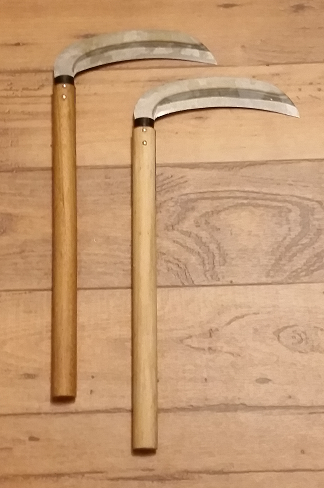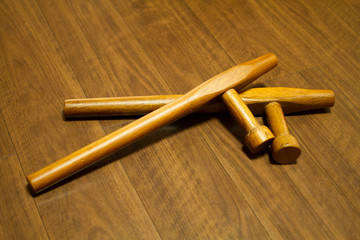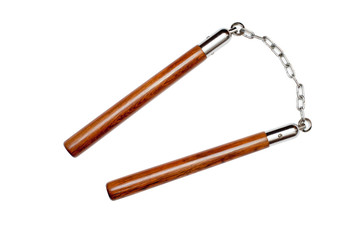Table of Contents
Previous chapter
By Graham Noble
There is another Okinawan karate style, Ryuei Ryu, which has similarities to Goju Ryu and which apparently shares some of its history. The modern headmaster of Ryuei Ryu, Kenko Nakaima (1911 – 1989) claimed that in the first half of the 19th century his grandfather Norisato (Kenri) Nakaima (1819 - 1879) had studied Chinese boxing in Fuzhou and Peijing with Master Liu Lung Kung, or “Ryu Ryu Ko” and had brought the forms he had learned back to Okinawa. That was in the 1840s and from then the style had been passed down in the family until Kenko decided to teach it publicly around 1970. Ryuei Ryu was a little known style of Okinawan karate until the 1980s when one of its practitioners, Tsuguo Sakumoto, became a three-time World Kata Champion and attracted notice with his strong and polished performances of one of the style’s unique kata, Anan.
The association entry for Ryuei Ryu in the 1977 Uechi book “Okinawa Karate Do” states that Kenri Nakaima went to Fuzhou at the age of nineteen and whilst there a former military envoy to Okinawa introduced him to a Chinese boxing teacher known as Ru Ru Ko, (Liu Lung Kung). Nakaima was accepted as a student and after years of practice (age 25?) received his master’s degree as well as several “secret books”: the Bubishi, Hyoronshi, Yojoho, Tokutsuki and Kanyushinpo. Before leaving China, in order to further his experience of the martial arts, Nakaima travelled in the Fujian, Guandong and Peijing areas where he collected many weapons which he brought home with him. The entry also notes that Ryu Ryu Ko was senior instructor at the Military Academy, and also that he actually came to Okinawa on the day that Kitoku Sakiyama, a well-known teacher of Te, was dying. Apparently he came just too late to see Sakiyama alive. According to this history, Sakiyama had gone to China with Nakaima and was a fellow student of Ryu Ryu Ko. Incidentally, those five secret books and the weapons that Kenri Nakaima had brought back from China in the middle of the 19th century were all destroyed in the Battle for Okinawa . . . That seems to be a recurring theme in the histories of those Okinawan karate schools claiming a direct Chinese heritage: invaluable historical documentation explaining their Chinese origins lost forever But are such stories true?
Anyway, Ryuei Ryu history is that Kenri Nakaima passed his Chinese boxing style in secret to his son Kenchu (1856 - 1953) who taught it only to his son Kenko Nakaima (1911 – 1989), founder and president of the Ryuei Ryu Karate and Kobudo Preservation Society. Mark Bishop visited Kenko Nakaima in his late sixties and noted that “His sense of guilt over breaking the secrecy pledge he had made to his father was still very obvious.” Bishop also noted that besides the practice of eleven empty hand kata, Ryuei Ryu also practised fourteen Chinese weapons, including the sai, kama, kon, tinbe, taofa (tonfa presumably), suruchin, and nunchaku.
The characters for Kenri Nakaima’s Chinese teacher Liu Lung Kung are given, and he is said to have been Ryu Ryu Ko, the same master who supposedly taught Kanryo Higaonna. So maybe there is some independent verification here of the story of Ryu Ryu Ko and Kanryo Higaonna.
The 1977 Ryuei Ryu entry in “Okinawa Karate Do” lists the style’s kata as: Sanchin, Seisan, Niseishi, Sanseru, Seiunchin, Ohan, Pachu, Anan, Paiku, Heiku, and Paiho. The first five forms and (possibly) Paiho are also found in other Okinawan styles, but Ohan, Pachu, Annan, Paiku, and Heiku are unique to Ryuei Ryu. Sanchin, Seiunchin, Sesan and Sanseru are also found in Goju Ryu, and apart from a few stylistic variations the Ryuei Ryu kata are very similar to the Goju forms. Again, then, Ryuei Ryu and Goju Ryu appear to share a common origin in China, and four common kata.
However, as Takao Nakaya points out in his “Karatedo History and Philosophy” if Kenri Nakaima’s teacher Liu Lung Kung and Ryu Ryu Ko are the same person, then there is a problem with dates. Nakaima’s dates are given as 1819 to 1879 and he is said to have gone to China at the age of nineteen, or around 1838, while Kanryo Higaonna is believed to have gone there in the 1870s. Those dates could be almost forty years apart, so it seems unlikely that the two Okinawans had the same teacher in China. What are the chances of two people going independently to China, or just the big city of Fuzhou, forty years apart and meeting the same teacher?
Strangely, considering the similarities between the two styles and their supposed historical links, Ryuei Ryu does not feature in any of the histories of Goju Ryu. Morio Higaonna, for example, does not mention the style in his history book. And there is a curious passage in an interview which Simon Lailey did with the Okinawan kobudo master Shinko Matayoshi, (“Combat” magazine, February 1992). In response to a question about the history of Kenko Nakaima’s Ryuei Ryu, Matayoshi replied that “I personally believe that Master Kenko Nakaima’s claim that Ryuei Ryu was originated by the Chinese master Ryu Ryu Ko is a figment of his own imagination.” In his accompanying text Simon went on to explain that “There then followed a few minutes of heated discussion with chuckles and laughs. I managed to establish that Matayoshi Sensei considered this style to be akin to Okinawan dancing . . . . He then said that, of course the style does exist – but only within the minds of those who practise it! Master Matayoshi went on to express his feelings about how ten years ago many of today’s kata did not exist; in a nutshell, Master Matayoshi believed that that these are merely imitations or interpretations of other authentic forms.”
The kata unique to Ryuei Ryu, Ohan, Pachu, Anan, Paiku and Heiku, contain quite a lot of open hand techniques – the use of the open hand is generally regarded as the mark of Chinese systems – but they don’t look much like Chinese forms, Northern or Southern; rather, they look like quite modern karate forms, with their angular embusen and block-strike-kick technique. It seems quite possible then, that as Matayoshi said, Kenko Nakaima developed these forms himself in the modern era, and that is pretty much confirmed in the third (2017) edition of Mark Bishop’s “Okinawan Karate”. Bishop writes that the style-specific Ryuei Ryu kata “were made up by Keko Nakaima in the 1960s, having been specifically designed for tournaments under the direction of Shigeru Nakamura, who then headed the Okinawa Kempo Association.” Bishop adds that the Ryuei Ryu Paiho goes back to Gokenki and that Anan, Tsuguo Sakamoto’s World Championship wiinning kata, may have been developed by Sakamoto himself. Ryuei Ryu was supposedly opened to the public only in 1971 and by that time Nakaima would have been sixty, old enough to have worked out all the movements of the new forms.
That doesn’t invalidate the style itself because Ryuei Ryu students seem to have strong, clean technique, at least on a par with other schools, and Sakumoto set a new benchmark in kata competition with his strong, clean forms and his three world championship wins. But there is obviously a question mark over the style history.
The mix of other kata in Ryuei Ryu is interesting: Sanchin, Seiunchin, Seisan, Sanseru, and Niseishi. Ryuei Ryu, then, shares that combination of Sanchin, Seisan and Sanseru with both Goju Ryu and Uechi Ryu, and apart from some stylistic variations the Ryuei Ryu versions of the kata, and its Seiunchin, are very similar to the Goju forms. Again, Mark Bishop writes that the Ryuei Ryu Sanseru may have come from Juei Tamaki, a Goju Ryu student of Seiko Higa.
But then Ryuei Ryu also has Niseishi, and it’s an unusual version of the kata. It starts and finishes similarly to the familiar Niseishi of Shito Ryu and other styles (such as Okinawa Kempo, or the version shown in Takada’s 1933 “Karate Kempo”, or the Shotokan Nijushiho), but then about half way in it goes into the right elbow strike-left punch technique which is repeated in four directions - just as it is in the Goju Ryu Sanseru. The Ryuei Ryu Niseishi, then, seems to be halfway between the orthodox Niseishi and the Goju Ryu Sanseru. What does that mean?
The usual explanation for the similarities between Ryuei Ryu’s Sanchin, Seiunchin, Sesan, Sanseru, and the Goju kata of the same name is that Kenri Nakaima had the same teacher as Kanryo Higaonna - Ryu Ryu Ko. But, even leaving aside the historical issues surrounding the figure of Ryu Ryu Ko, that problem of dates make this improbable. It’s stretching credibility to believe that Kanryo Higaonna went to China almost forty years after Kenko Nakaima’s ancestor and independently brought back the same familiar kata, (which may well be kata of Okinawan origin anyway). Who knows, Nakaima may have got at least some of his kata – Sanchin, Sesan, Sanseru and Niseishi - from his father, or maybe he learned them later, from another teacher, or teachers. We don’t fully understand the origins of the style, but it’s quite possible that Nakaima latched onto other known “histories” to produce a prestigious lineage for his teaching. In any case, for a variety of reasons we can’t rely on Ryuei Ryu to help us with the history of Goju.
The period from the later 19th Century going into the early 20th Century is most mysterious, but it was probably pivotal in the development of modern karate. It was a unique transitionary period between the old and the new, when karate was opening up to the public and there were various teachers around with their own versions of particular kata. There was little standardisation at that point, although it came soon enough. This was the period when the modern styles of Okinawan karate emerged, but we know almost nothing about it. I think it’s why we see these puzzling correspondences between kata of different styles: because they all emerged from the same melting pot – but in Okinawa, not China.
In the entry for Ryuei Ryu in the 1977 “Okinawa Karate Do” style directory Genko Nakaima wrote that he studied karate from his father from a young age but wasn’t awarded full qualification in Ryuei Ryu until he was thirty seven, (1948). Nakaima added that when he was at school he studied karate from “Chojo Oshiro, of Itosu–kei (stream) and Sensei Yabu, who was of the Matsumura-kei,” noting that Oshiro also taught kobudo in Kanagushi-mura. Nakaima also learned kendo from Seibu Tomegawa and Hiroshi Ishihara when he was a student at the Okinawa School for Teachers, and he wrote that after graduation he was taught by Masanao Ishihara. It’s interesting that the Ryuei Ryu kata Paiho has clear similarities to the Crane kata Hakucho practiced in Kenwa Mabuni’s Shito Ryu, and in an article by John Sells on Ryuei Ryu instructor Tomohiro Arashiro, (“Bugeisha” No. 3, 1997) John noted that according to Arasahiro, “Paiho is really another name for Hakutsuru (White Crane), and was brought into Ryuei Ryu by Kenko Nakaima, who ostensibly learned it from Gokenki, the Chinese-Okinawan tea merchant who taught extensively in the 1920s and 1930s.” In a letter to me dated November 1998 John also stated that Kenko Nakaima had told various people that he had got Paiho kata from Gokenki. So Gokenki may have been another Genko Nakaima teacher. It’s apparent that the young Nakaima was a keen student of karate and martial arts and sought out instruction where he could. There may have been other teachers that he never mentioned, but the idea that he was a grand student of the Chinese Ryu Ryu Ko – I don’t buy that at all.
Next chapter
2. The Mysteries of Naha Te (D)
Moderator: Available
2. The Mysteries of Naha Te (D)
Erik
“Old minds are like old horses; you must exercise them if you wish to keep them in working order.”
- John Adams
“Old minds are like old horses; you must exercise them if you wish to keep them in working order.”
- John Adams
Re: 2. The Mysteries of Naha Te (D)
"Ryuei Ryu also practised fourteen Chinese weapons, including the sai, kama, kon, tinbe, taofa (tonfa presumably), suruchin, and nunchaku."
Sai:

Kama:

Bo (kon):

Tinbe (shield):

Taofa (tonfa presumably):

Suruchin:

Nunchaku:

Sai:

Kama:

Bo (kon):

Tinbe (shield):

Taofa (tonfa presumably):

Suruchin:

Nunchaku:

Erik
“Old minds are like old horses; you must exercise them if you wish to keep them in working order.”
- John Adams
“Old minds are like old horses; you must exercise them if you wish to keep them in working order.”
- John Adams
